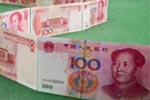Price stability still top priority: PBOC
Updated: 2011-09-12 11:43
(Xinhua)
|
|||||||||||
BEIJING - The People's Bank of China (PBOC), the country's central bank, reiterated on Monday that stabilizing the overall price levels remained the top priority of macro-economic regulation.
Some factors that drive prices upward have been contained but not eliminated, while inflation remains relatively high, the central bank said in a statement on its website.
It said the country will continue the prudent monetary policy and keep the growth of credit stable and moderate.
China's consumer price index, a main gauge of inflation, surged by a 37-month high of 6.5 percent in July before cooling to 6.2 percent in August, still among the highest levels in the past three years.
Analysts have blamed soaring food prices and a lending boom following the country's stimulus package in late 2008 for the stubbornly high inflation rates.
Prices of food, which account for about one-third in the basket of goods used to calculate China's CPI, surged 13.4 percent year-on-year in August.
To mop up the excessive liquidity that helps fuel inflation, the PBOC has ordered the nation's banks to set aside a record high of 21.5 percent of their cash in reserves and has also increased benchmark interest rates five times since October.
Peng Wensheng, an analyst with China International Capital Corp, said another interest rate hike is expected within the year, most likely in September or October.
According to PBOC statistics, by the end of August, the outstanding of broad money supply (M2), which covers cash in circulation and all deposits, rose 13.5 percent year-on-year to 78.07 trillion yuan ($12.20 trillion), down 1.2 percentage points from July growth and 5.7 percentage growth one year ago.
The slowdown in M2 growth was in line with the country's prudent monetary policy, and current liquidity conditions remained compatible with the country's stable and relatively fast economic growth, the central bank said.
The PBOC also said it is researching a new "M2+" measure to cover wider money supply metrics as current M2 data had underestimated the total real liquidity due to the introduction of wealth management products.
Related Stories
Price index softens for first time in several months 2011-09-10 14:56
Oil price adjustment may not happen 2011-09-02 15:52
Wen: Price regulation top priority 2011-08-31 18:36
Government should refine gas price mechanism 2011-08-26 11:41
China releases more reserve sugar to curb price hikes 2011-08-17 15:54
- Local debts controllable amid tightening regulations
- New yuan loans hit 548.5b yuan in August
- Price stability still top priority
- Fair shows demand for China's ODI
- Safety checks for offshore oil firms
- HK to boost yuan's internationalization
- China's August exports grow 24.5%
- Love and fear of Chinese investment













